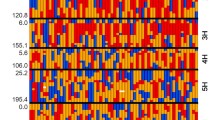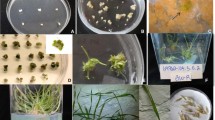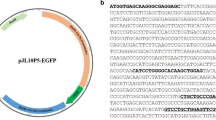Abstract
Key message
The genetic substitution of transformation amenability alleles from ‘Golden Promise’ can facilitate the development of transformation-efficient lines from recalcitrant barley cultivars.
Abstract
Barley (Hordeum vulgare) cv. ‘Golden Promise’ is one of the most useful and well-studied cultivars for genetic manipulation. In a previous report, we identified several transformation amenability (TFA) loci responsible for Agrobacterium-mediated transformation using the F2 generation of immature embryos, derived from ‘Haruna Nijo’ × ‘Golden Promise,’ as explants. In this report, we describe higher density mapping of these TFA regions with additional SNP markers using the same transgenic plants. To demonstrate the robustness of transformability alleles at the TFA loci, we genotyped 202 doubled haploid progeny from the cross ‘Golden Promise’ × ‘Full Pint.’ Based on SNP genotype, we selected lines having ‘Golden Promise’ alleles at TFA loci and used them for transformation. Of the successfully transformed lines, DH120366 came the closest to achieving a level of transformation efficiency comparable to ‘Golden Promise.’ The results validate that the genetic substitution of TFA alleles from ‘Golden Promise’ can facilitate the development of transformation-efficient lines from recalcitrant barley cultivars.




Similar content being viewed by others
References
Anand A, Krichevsky A, Schornack S, Lahaye T, Tzfira T, Tang Y, Citovsky V, Mysore KS (2007) Arabidopsis VIRE2 INTERACTING PROTEIN2 is required for Agrobacterium T-DNA integration in Plants. Plant Cell 19:1695–1708
Cheng M, Lowe BA, Spencer TM, Ye X, Armstrong CL (2004) Factors influencing Agrobacterium-mediated transformation of monocotyledonous species. In Vitro Cell Dev Biol Plant 40:31–45
Cistué L, Ramos A, Castillo AM, Romagosa I (1994) Production of large number of doubled haploid plants from barley anthers pretreated with high concentrations of mannitol. Plant Cell Rep 13:709–712
Close TJ, Bhat PR, Lonardi S, Wu Y, Rostoks N, Ramsay L, Druka A, Stein N, Svensson JT, Wanamaker S, Bozdag S, Roose ML, Moscou MJ, Chao S, Varshney RK, Szűcs P, Sato K, Hayes PM, Matthews DE, Kleinhofs A, Muehlbauer GJ, DeYoung J, Marshall DF, Madishetty K, Fenton RD, Condamine P, Graner A, Waugh R (2009) Development and implementation of high-throughput SNP genotyping in barley. BMC Genom 10:1–13
Cogan NOI, Newbury HJ, Oldacres AM, Lynn JR, Kearsey MJ, King GJ, Puddephat IJ (2004) Identification and characterization of QTL controlling Agrobacterium-mediated transient and stable transformation of Brassica oleracea. Plant Biotechnol J 2:59–69
Comadran J, Kilian B, Russell J, Ramsay L, Stein N, Ganal M, Shaw P, Bayer M, Thomas W, Marshall D, Hedley P, Tondelli A, Pecchioni N, Francia E, Korzun V, Walther A, Waugh R (2012) Natural variation in a homolog of Antirrhinum CENTRORADIALIS contributed to spring growth habit and environmental adaptation in cultivated barley. Nat Genet 44:1388–1392
Deng W, Casao MC, Wang P, Sato K, Hayes PM, Finnegan EJ, Trevaskis B (2015) Direct links between the vernalization response and other key traits of cereal crops. Nat Commun 6:5882
Echávarri B, Cistué L (2016) Enhancement in androgenesis efficiency in barley (Hordeum vulgare L.) and bread wheat (Triticum aestivum L.) by the addition of dimethyl sulfoxide to the mannitol pretreatment medium. Plant Cell Tiss Organ Cult 125:11–22
Harwood WA (2012) Advances and remaining challenges in the transformation of barley and wheat. J Exp Bot 63:1791–1798
Hensel G, Valkov V, Middlefell-Williams J, Kumlehn J (2008) Efficient generation of transgenic barley: The way forward to modulate plant–microbe interactions. J Plant Physiol 165:71–82
Hisano H, Sato K (2016) Genomic regions responsible for amenability to Agrobacterium-mediated transformation in barley. Sci Rep 6:37505
Ikeuchi M, Sugimoto K, Iwase A (2013) Plant callus: mechanisms of induction and repression. The Plant Cell 25:3159–3173
Ikeuchi M, Ogawa Y, Iwase A, Sugimoto K (2016) Plant regeneration: cellular origins and molecular mechanisms. Development 143:1442–1451
Iwata H, Ninomiya S (2006) AntMap: Constructing genetic linkage maps using an ant colony optimization algorithm. Breed Sci 56:371–377
Kumlehn J, Serazetdinova L, Hensel G, Becker D, Loerz H (2006) Genetic transformation of barley (Hordeum vulgare L.) via infection of androgenetic pollen cultures with Agrobacterium tumefaciens. Plant Biotechnol J 4:251–261
Lowe K, Wu E, Wang N, Hoerster G, Hastings C, Cho M-J, Scelonge C, Lenderts B, Chamberlin M, Cushatt J, Wang L, Ryan L, Khan T, Chow-Yiu J, Hua W, Yu M, Banh J, Bao Z, Brink K, Igo E, Rudrappa B, Shamseer PM, Bruce W, Newman L, Shen B, Zheng P, Bidney D, Falco SC, Register JC III, Zhao Z-Y, Xu D, Jones TJ, Gordon-Kamm WJ (2016) Morphogenic regulators Baby boom and Wuschel improve monocot transformation. Plant Cell 28:1998–2015
Lü B, Wu J-J, Fu D-l (2015) Constructing the barley model for genetic transformation in Triticeae. J Integr Agric 14:453–468
Mrízová K, Holasková E, Öz MT, Jiskrová E, Frébort I, Galuszka P (2014) Transgenic barley: a prospective tool for biotechnology and agriculture. Biotechnol Adv 32:137–157
Nam J, Matthysse AG, Gelvin SB (1997) Differences in susceptibility of Arabidopsis ecotypes to crown gall disease may result from a deficiency in T-DNA integration. Plant Cell 9:317–333
Nigorikawa M, Watanabe A, Furukawa K, Sonoki T, Ito Y (2012) Enhanced saccharification of rice straw by overexpression of rice exo-glucanase. Rice 5:14
Nishimura A, Aichi I, Matsuoka M (2007) A protocol for Agrobacterium-mediated transformation in rice. Nat Protoc 1:2796–2802
Sato K, Yamane M, Yamaji N, Kanamori H, Tagiri A, Schwerdt JG, Fincher GB, Matsumoto T, Takeda K, Komatsuda T (2016) Alanine aminotransferase controls seed dormancy in barley. Nat Commun 7:11625
Sparrow PAC, Townsend TM, Arthur A, Dale PJ, Irwin JA (2004) Genetic analysis of Agrobacterium tumefaciens susceptibility in Brassica oleracea. Theor Appl Genet 108:644–650
The International Barley Sequencing Consortium (IBSC) (2012) A physical, genetic and functional sequence assembly of the barley genome. Nature 491:711–716
Tingay S, McElroy D, Kalla R, Fieg S, Wang M, Thornton S, Brettell R (1997) Agrobacterium tumefaciens-mediated barley transformation. Plant J 11:1369–1376
Yeo FKS, Hensel G, Vozábová T, Martin-Sanz A, Marcel TC, Kumlehn J, Niks RE (2014) Golden SusPtrit: a genetically well transformable barley line for studies on the resistance to rust fungi. Theor Appl Genet 127:325–337
Zhang X, Henriques R, Lin S-S, Niu Q-W, Chua N-H (2006) Agrobacterium-mediated transformation of Arabidopsis thaliana using the floral dip method. Nat Protoc 1:641–646
Acknowledgements
We thank Tanya Filichkin and Laura Helgerson for their parts in developing the Oregon Promise population, Yuka Motoi (IPSR, Okayama Univ.) for technical assistance, and Dr. Yukihiro Ito (Tohoku Univ., Japan) for providing the pBUH3 vector. This work was supported by the Spanish Ministry of Science and Innovation (Project AGL2015-69435-C3-2-R) to L.C., the Gatsby Foundation and BBSRC Institutional Strategic Programme (BB/J004553/1) to M.M., and JSPS KAKENHI, Grant Numbers 24880025 and 16K18634 to H.H.
Author information
Authors and Affiliations
Corresponding author
Ethics declarations
Conflict of interest
The authors declare that they have no conflict of interest.
Additional information
Communicated by Mark C. Jordan.
Electronic supplementary material
Below is the link to the electronic supplementary material.
Rights and permissions
About this article
Cite this article
Hisano, H., Meints, B., Moscou, M.J. et al. Selection of transformation-efficient barley genotypes based on TFA (transformation amenability) haplotype and higher resolution mapping of the TFA loci. Plant Cell Rep 36, 611–620 (2017). https://doi.org/10.1007/s00299-017-2107-2
Received:
Accepted:
Published:
Issue Date:
DOI: https://doi.org/10.1007/s00299-017-2107-2




